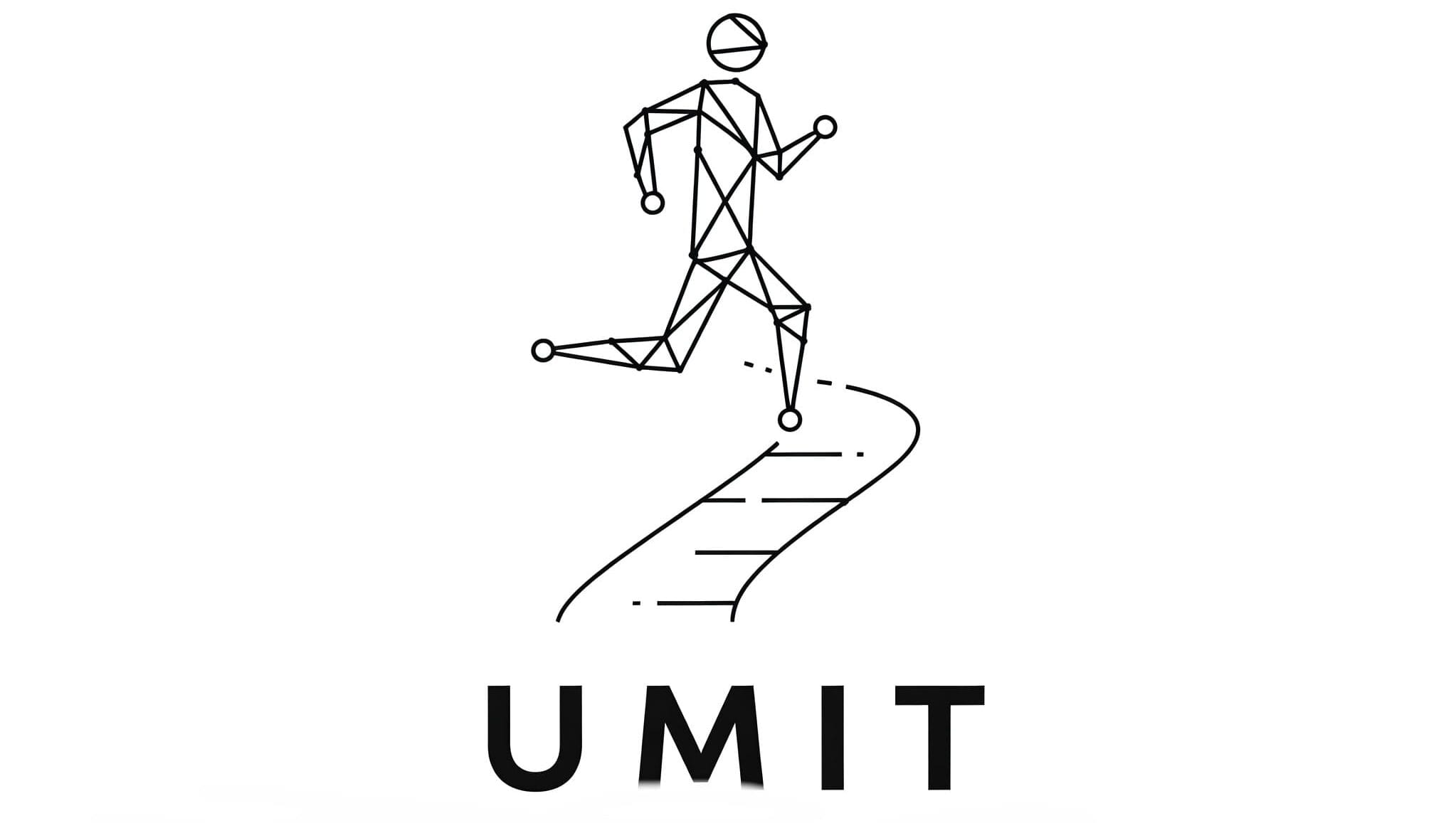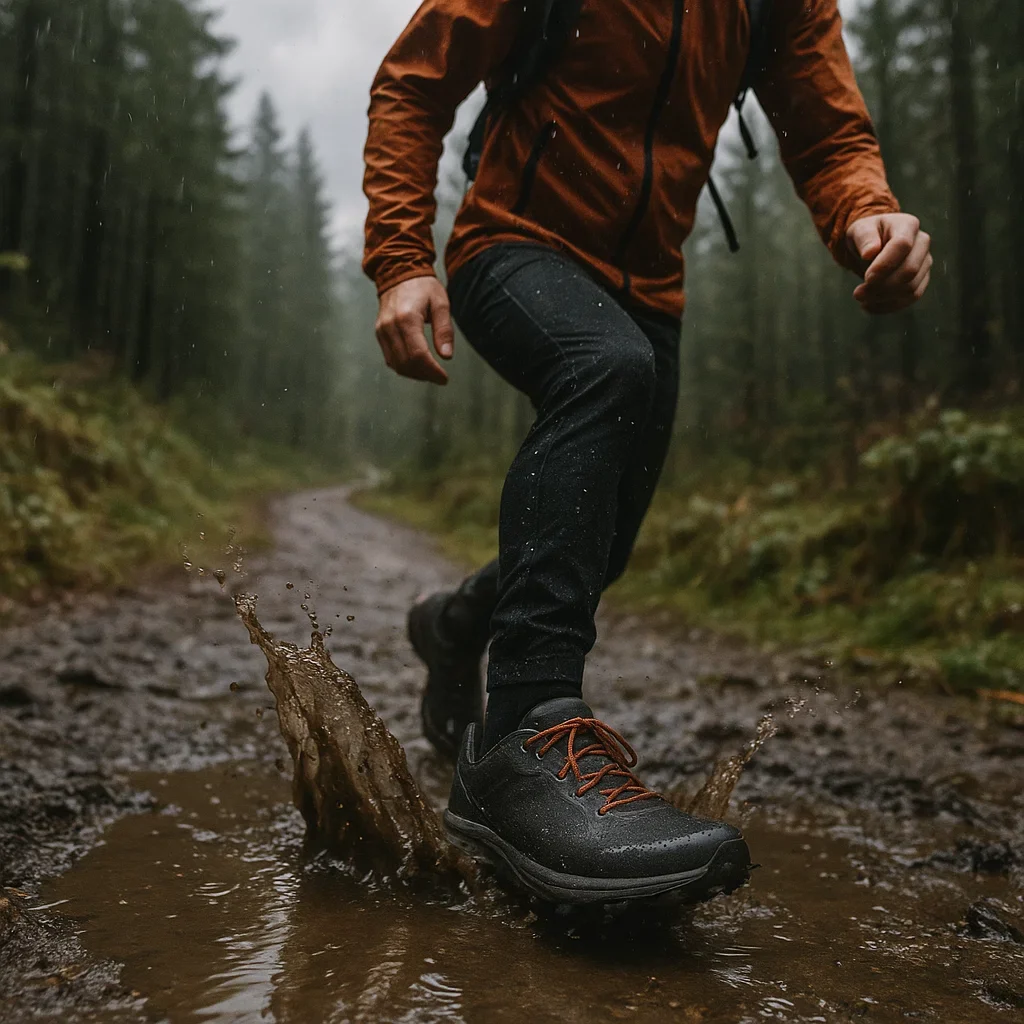Don’t let rain, mud, or surprise stream crossings ruin your hike! Whether you’re trekking through wet forests, climbing muddy hills, or just want dry, warm feet all day long, waterproof trail running shoes can be a game-changer for hikers.
Want a full overview of all trail shoe types? Check our Best Trail Running Shoes for Hiking pillar guide.
🧪 What Makes a Trail Running Shoe Waterproof?
Waterproof trail shoes use special membranes—most famously GORE-TEX®—that block water from getting in while still allowing some sweat vapor to escape. Other technologies like eVent®, OutDry®, or proprietary blends from Salomon, Hoka, or Altra are also common.
These membranes are sandwiched between the shoe’s outer fabric and inner lining, acting like an invisible raincoat for your feet.
- GORE-TEX®: Gold standard for waterproofing, widely trusted for its durability and breathability.
- eVent®: Competes closely with GORE-TEX®, often a bit more breathable but slightly less durable.
- Proprietary Membranes: Brands like Salomon “ClimaSalomon™” or Hoka “SkyShell™” offer strong protection, often at a lower price point.
Mesh vs Membrane: Regular mesh shoes dry super-fast but soak through instantly. Waterproof membranes keep water out but add weight and may run warmer.
| Feature | Waterproof (Membrane) | Non-Waterproof (Mesh) |
|---|---|---|
| Waterproofing | Excellent 🚫💧 | Poor, dries fast |
| Breathability | Moderate 😅 | Maximum 🌬️ |
| Weight | Higher 🏋️ | Lighter 🪶 |
| Best For | Wet, cold, muddy hikes | Hot, dry, summer hikes |
🌧️ Benefits of Waterproof Trail Running Shoes for Hiking
- Stay Dry in Rain & Mud: Waterproof shoes keep feet dry through puddles, rain, morning dew, and shallow streams. Essential for autumn, winter, or highland trails.
- Warmth in Cold Weather: The membrane blocks wind and cold air, making hikes in chilly conditions much more comfortable.
- Less Sock Management: No more stopping every hour to wring out wet socks!
- Peace of Mind: Sudden weather change? Stream crossing? No problem—your shoes have you covered.
Best for: Wet forests, high-altitude hikes, cold mornings, or any trail where staying dry is key.
⚠️ Limitations & Downsides
- Breathability: Membranes trap more sweat, which can mean damp socks on warm days.
- Weight: Waterproof shoes are typically 30–50g heavier per shoe compared to mesh versions.
- Drying Time: Once water gets inside (e.g., over the collar), shoes dry much slower than mesh.
- Heat: Can feel uncomfortably warm in summer or fast hiking/running.
Pro tip: For summer or hot climates, use mesh trail shoes and let your feet dry naturally—even if they get wet, they’ll usually dry fast while you hike.
🏆 2025’s Best Waterproof Trail Running Shoes for Hiking
| Model | Weight | Membrane | Grip | Best Use |
|---|---|---|---|---|
| Salomon Sense Ride 5 GTX | ~298g | GORE-TEX® | ⭐⭐⭐⭐⭐ | Mixed, technical, wet weather |
| Hoka Speedgoat 6 GTX | ~290g | GORE-TEX® | ⭐⭐⭐⭐⭐ | Muddy trails, cold/rainy climates |
| La Sportiva Bushido II GTX | ~320g | GORE-TEX® | ⭐⭐⭐⭐ | Rocky, mountain, alpine |
| Brooks Cascadia 17 GTX | ~315g | GORE-TEX® | ⭐⭐⭐⭐ | All-round, travel, varied weather |
| Merrell Moab Flight GTX | ~305g | GORE-TEX® | ⭐⭐⭐ | Entry level, daily hikes, city-trail mix |
- Salomon Sense Ride 5 GTX: “Best all-rounder.” Outstanding grip, fits most feet, proven waterproofing, perfect for Turkish mountains and mixed weather. Not for very wide feet.
- Hoka Speedgoat 6 GTX: “Maximum cushion & grip.” Superb in mud, ultra distances, or for those with joint pain. Slightly higher stack—great for soft ground, less ideal for rocky technical scrambling.
- La Sportiva Bushido II GTX: “Alpine specialist.” Ultra-secure fit, fantastic protection, a bit firmer ride. Perfect for mountain storms.
- Brooks Cascadia 17 GTX: “Reliable classic.” Solid all-rounder, ideal for those wanting a stable, trustworthy shoe for all seasons.
- Merrell Moab Flight GTX: “Budget-friendly option.” Comfy, good for easy trails, urban hikes, or travel. Grip and durability less than premium models.
🔍 How to Choose the Best Waterproof Trail Shoe
- Consider your climate: Wet, cold, unpredictable? Go waterproof. Hot, dry? Stick with mesh.
- Hiking style: Fast and light? Choose the lowest weight membrane model. Slow and steady? Extra protection may help.
- Fit: Try on with hiking socks; check toe room, secure heel, and no pinch at the midfoot.
- Key features: Look for gusseted tongue (keeps out water/debris), robust toe bumper, and strong lacing system. Drainage ports and higher cuff can be useful for deeper puddles.
- Break-in: Even waterproof shoes need a short break-in to soften the upper and flex points.
🧼 Care & Maintenance Tips
- Rinse mud and grit after every hike with fresh water.
- Let shoes air dry at room temperature; never use direct heat or sunlight.
- Use a spray-on DWR (Durable Water Repellent) treatment every few months to boost beading and keep membrane working.
- If the shoe gets soaked inside, remove insoles and stuff with newspaper to speed drying.
- Retire waterproof shoes when the membrane is punctured, heavily worn, or loses water resistance (usually 600–900km).
🧑🦯 Real-World Experiences
“Hiking through spring rain in the Kaçkar Mountains, my Sense Ride 5 GTXs kept my feet bone dry, even after a surprise thunderstorm. The peace of mind was priceless.”
– Deniz, Trabzon
“I love waterproof shoes for autumn and winter, but in summer, my feet get too hot. I switch to mesh after May—it’s worth having both!”
– Kaan, Bursa
“On multi-day hikes, nothing beats the confidence of dry socks—even when the weather turns nasty!”
– Melis, Artvin
❓ Frequently Asked Questions
💦 Are waterproof trail shoes really 100% waterproof?
🥾 Can I use waterproof trail shoes in the summer?
⏳ How long do waterproof trail shoes last?
🧦 Do I need special socks for waterproof trail shoes?
🧽 How do I restore water repellency?
🌊 What if water gets inside?
🩴 Are waterproof trail shoes heavier than regular ones?
🦶 Should I size up for waterproof shoes?
🏔️ Are they good for mountain trekking?
🤔 Should I buy waterproof or non-waterproof trail shoes?
📚 Further Reading
- Switchback Travel: Best Waterproof Trail Running Shoes – Up-to-date reviews and performance tips.
- REI: Rainy Weather Hiking Tips – How to hike happily in the wettest conditions.
- OutdoorGearLab: Best Trail Running Shoes – Side-by-side comparison, including waterproof options.
Final Thoughts
Wet, muddy, or cold adventures? The right waterproof trail running shoes keep your feet dry, happy, and blister-free. Remember: No shoe is perfect for every season—consider having both a waterproof and a mesh model to cover all your hiking dreams!
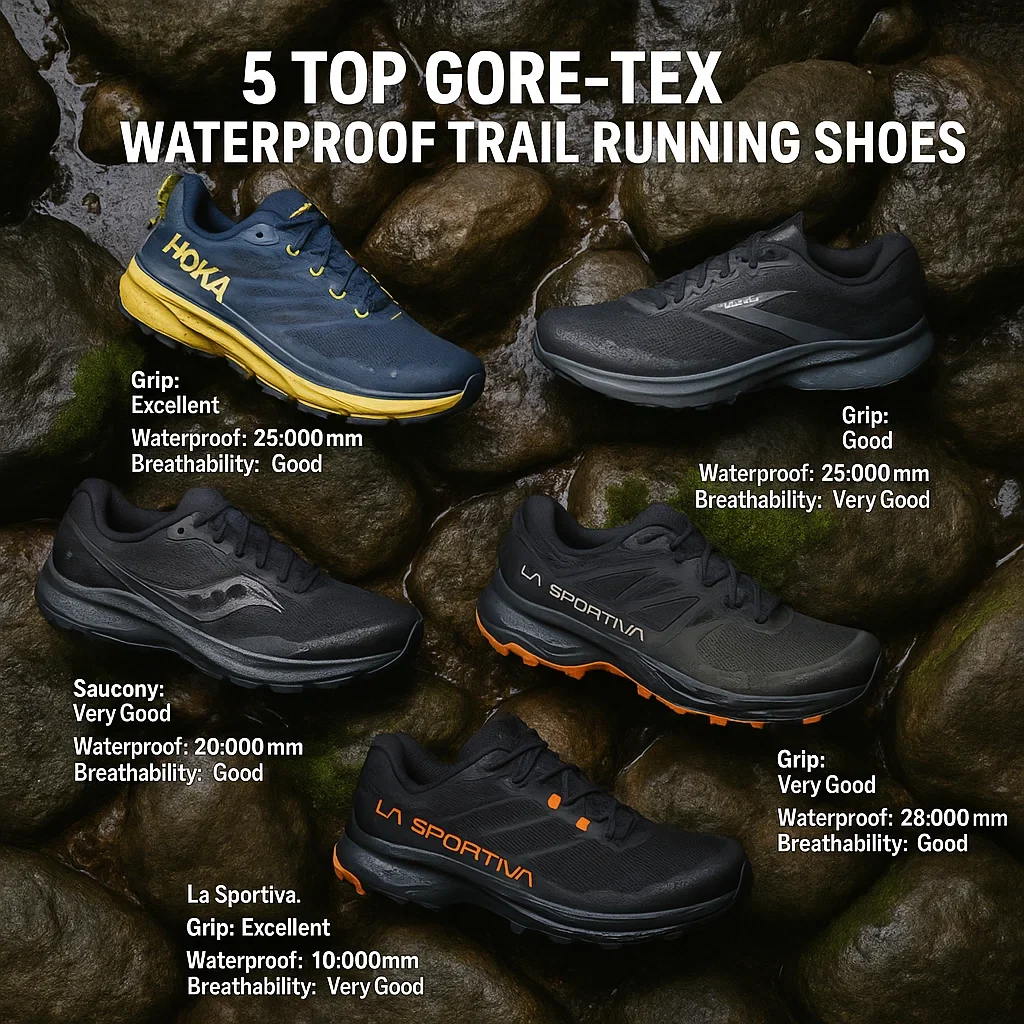
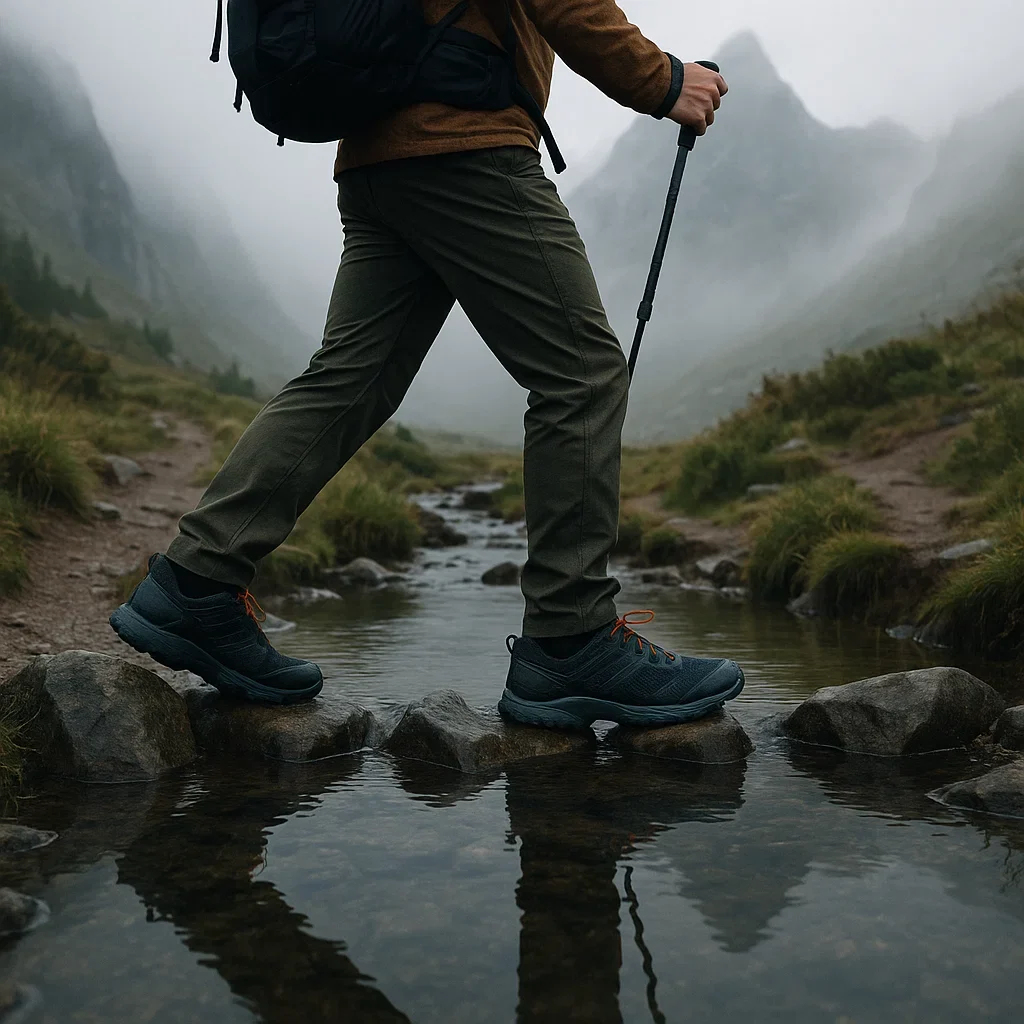
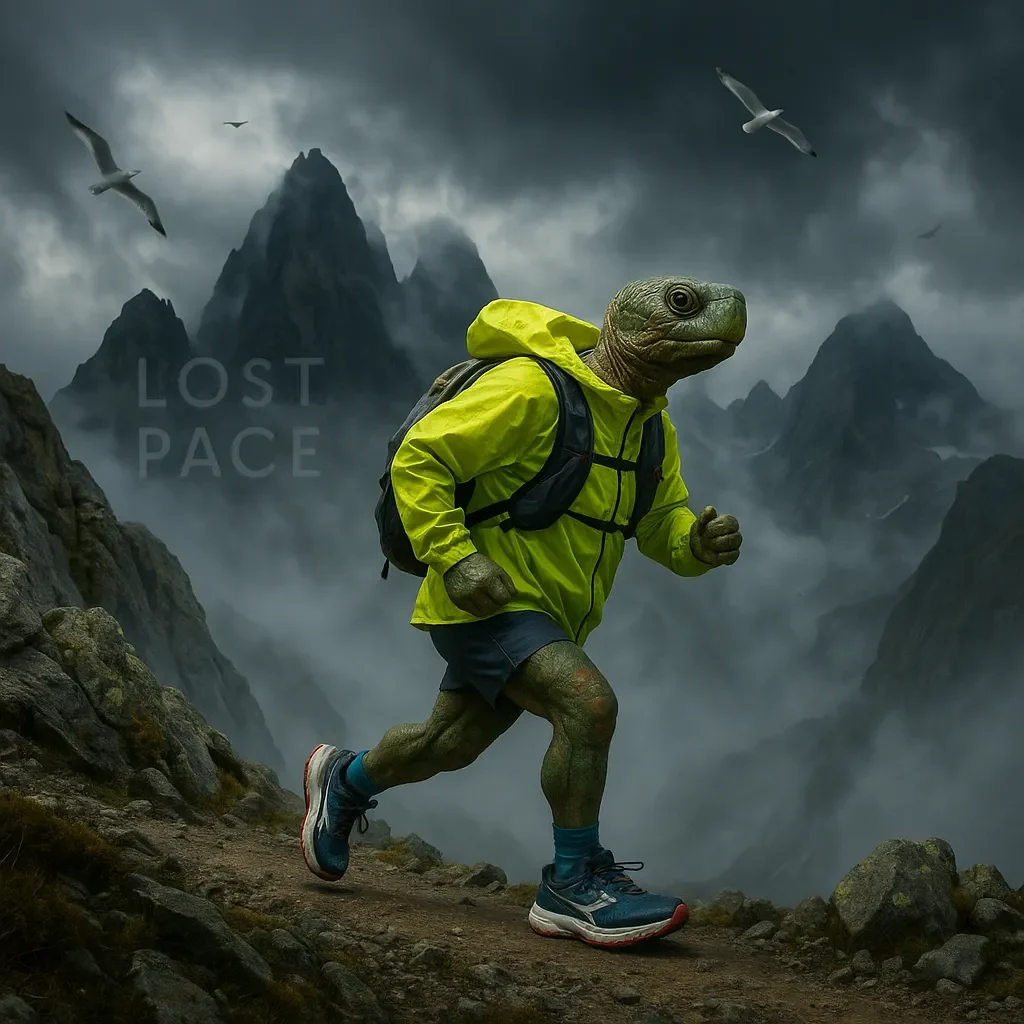
About the Author
Lost Pace is an ultramarathon runner, shoe-tester and the founder of umit.net. Based year-round in Türkiye’s rugged Kaçkar Mountains, he has logged 10,000 + km of technical trail running and completed multiple 50 K–100 K ultras.
Blending mountain grit with data, Lost analyses power (CP 300 W), HRV and nutrition to craft evidence-backed training plans. He has co-written 260 + long-form guides on footwear science, recovery and endurance nutrition, and is a regular beta-tester of AI-driven coaching tools.
When he isn’t chasing PRs or testing midsoles, you’ll find him sharing peer-reviewed research in plain English to help runners train smarter, stay healthier and finish stronger.
Ultrarunner · Data geek · Vegan athlete
